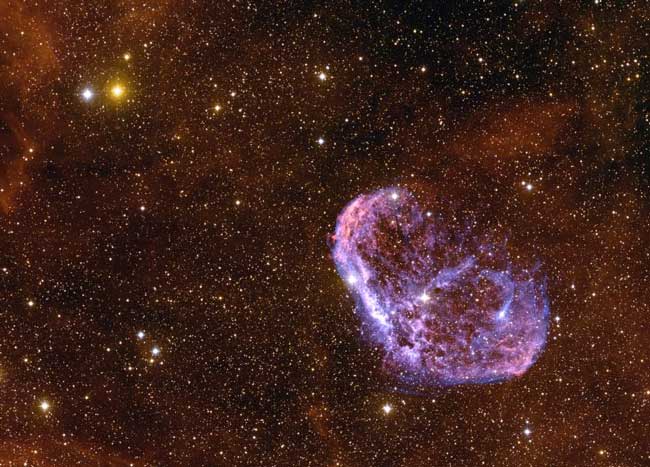
|
Explanation: What caused the Crescent Nebula? Looking like an emerging space cocoon, the Crescent Nebula, visible on the right, was created by the brightest star in its center. A leading progenitor hypothesis has the Crescent Nebula beginning to form about 250,000 years ago. At that time, the massive central star had evolved to become a Wolf-Rayet star (WR 136), shedding its outer envelope in a strong stellar wind, ejecting the equivalent of our Sun's mass every 10,000 years. This wind impacted surrounding gas left over from a previous phase, compacting it into a series of complex shells, and lighting it up. The Crescent Nebula, also known as NGC 6888, lies about 4,700 light-years away in the constellation of Cygnus. Star WR 136 will probably undergo a supernova explosion sometime in the next million years.
|
January February March April May June July August September October November December |
| ||||||||||||||||||||||||||||||||||||||||||||||||
NASA Web Site Statements, Warnings, and Disclaimers
NASA Official: Jay Norris. Specific rights apply.
A service of: LHEA at NASA / GSFC
& Michigan Tech. U.
Based on Astronomy Picture
Of the Day
Publications with keywords: Crescent Nebula - NGC 6888 - Wolf-Rayet star
Publications with words: Crescent Nebula - NGC 6888 - Wolf-Rayet star
See also:
- APOD: 2025 March 17 Á Thors Helmet
- APOD: 2025 February 3 Á Wolf Rayet Star 124: Stellar Wind Machine
- APOD: 2025 January 29 Á Dust Shells around WR 140 from Webb
- APOD: 2024 November 12 Á NGC 6888: The Crescent Nebula
- Sharpless 308: The Dolphin Head Nebula
- APOD: 2024 January 9 Á Thors Helmet
- APOD: 2023 September 4 Á Cygnus: Bubble and Crescent
